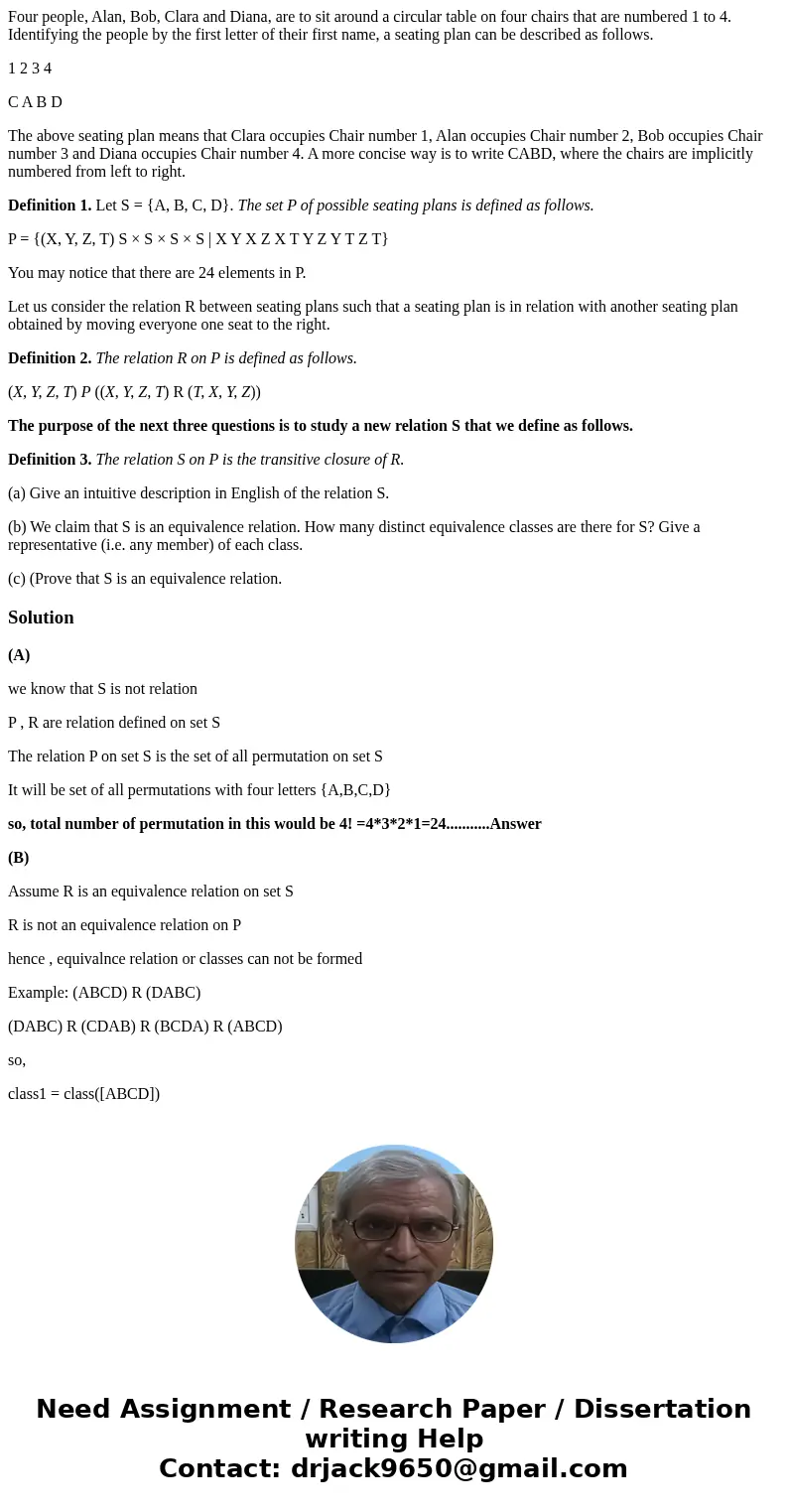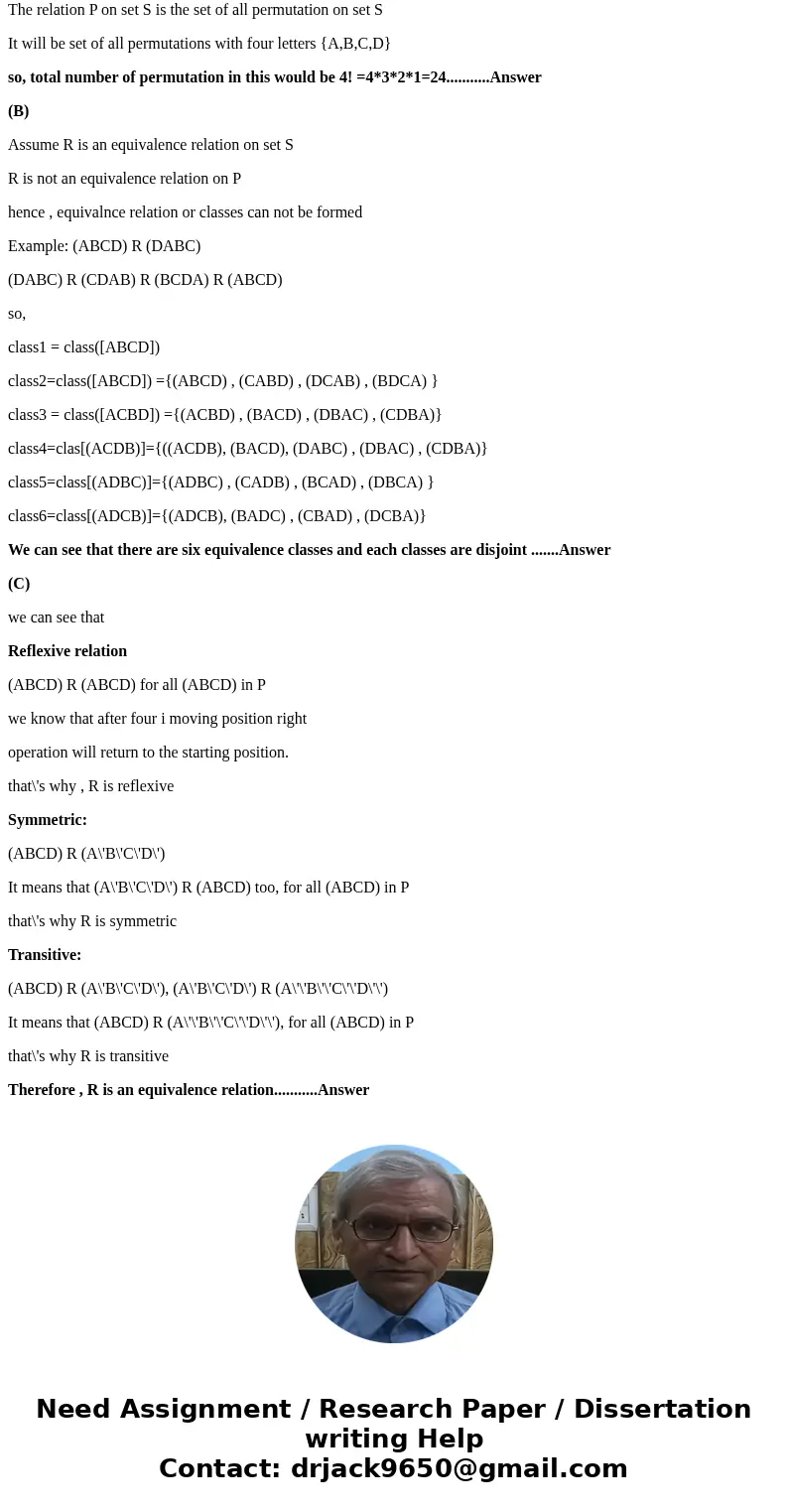Four people Alan Bob Clara and Diana are to sit around a cir
Four people, Alan, Bob, Clara and Diana, are to sit around a circular table on four chairs that are numbered 1 to 4. Identifying the people by the first letter of their first name, a seating plan can be described as follows.
1 2 3 4
C A B D
The above seating plan means that Clara occupies Chair number 1, Alan occupies Chair number 2, Bob occupies Chair number 3 and Diana occupies Chair number 4. A more concise way is to write CABD, where the chairs are implicitly numbered from left to right.
Definition 1. Let S = {A, B, C, D}. The set P of possible seating plans is defined as follows.
P = {(X, Y, Z, T) S × S × S × S | X Y X Z X T Y Z Y T Z T}
You may notice that there are 24 elements in P.
Let us consider the relation R between seating plans such that a seating plan is in relation with another seating plan obtained by moving everyone one seat to the right.
Definition 2. The relation R on P is defined as follows.
(X, Y, Z, T) P ((X, Y, Z, T) R (T, X, Y, Z))
The purpose of the next three questions is to study a new relation S that we define as follows.
Definition 3. The relation S on P is the transitive closure of R.
(a) Give an intuitive description in English of the relation S.
(b) We claim that S is an equivalence relation. How many distinct equivalence classes are there for S? Give a representative (i.e. any member) of each class.
(c) (Prove that S is an equivalence relation.
Solution
(A)
we know that S is not relation
P , R are relation defined on set S
The relation P on set S is the set of all permutation on set S
It will be set of all permutations with four letters {A,B,C,D}
so, total number of permutation in this would be 4! =4*3*2*1=24...........Answer
(B)
Assume R is an equivalence relation on set S
R is not an equivalence relation on P
hence , equivalnce relation or classes can not be formed
Example: (ABCD) R (DABC)
(DABC) R (CDAB) R (BCDA) R (ABCD)
so,
class1 = class([ABCD])
class2=class([ABCD]) ={(ABCD) , (CABD) , (DCAB) , (BDCA) }
class3 = class([ACBD]) ={(ACBD) , (BACD) , (DBAC) , (CDBA)}
class4=clas[(ACDB)]={((ACDB), (BACD), (DABC) , (DBAC) , (CDBA)}
class5=class[(ADBC)]={(ADBC) , (CADB) , (BCAD) , (DBCA) }
class6=class[(ADCB)]={(ADCB), (BADC) , (CBAD) , (DCBA)}
We can see that there are six equivalence classes and each classes are disjoint .......Answer
(C)
we can see that
Reflexive relation
(ABCD) R (ABCD) for all (ABCD) in P
we know that after four i moving position right
operation will return to the starting position.
that\'s why , R is reflexive
Symmetric:
(ABCD) R (A\'B\'C\'D\')
It means that (A\'B\'C\'D\') R (ABCD) too, for all (ABCD) in P
that\'s why R is symmetric
Transitive:
(ABCD) R (A\'B\'C\'D\'), (A\'B\'C\'D\') R (A\'\'B\'\'C\'\'D\'\')
It means that (ABCD) R (A\'\'B\'\'C\'\'D\'\'), for all (ABCD) in P
that\'s why R is transitive
Therefore , R is an equivalence relation...........Answer


 Homework Sourse
Homework Sourse